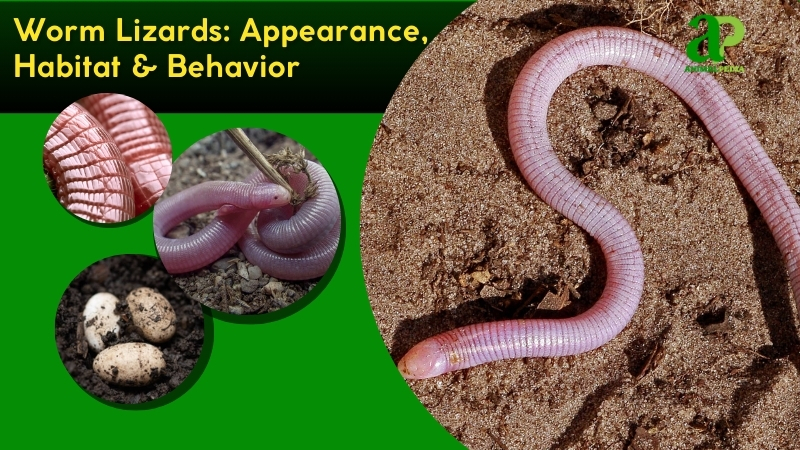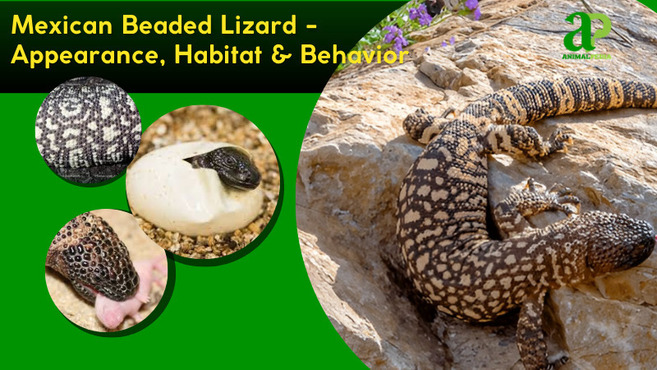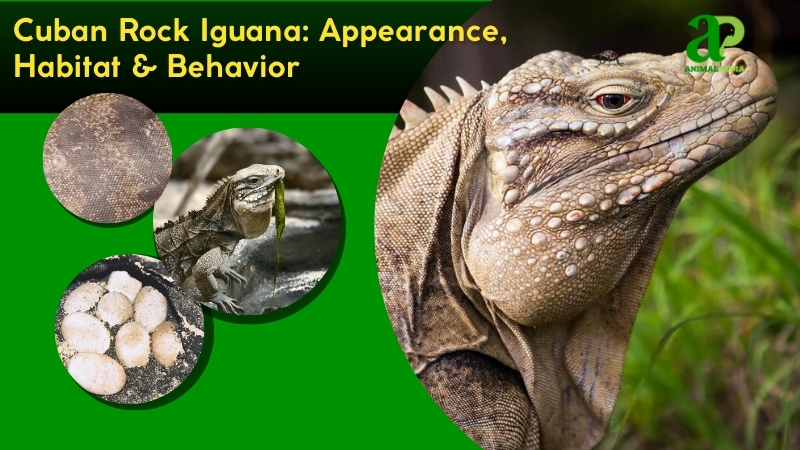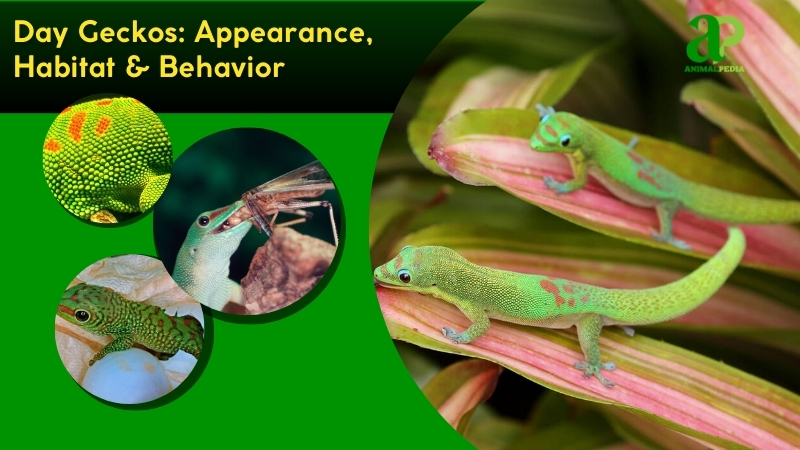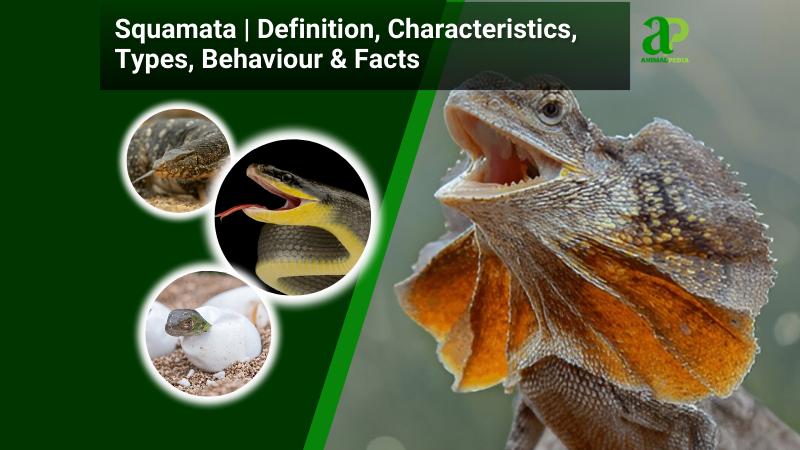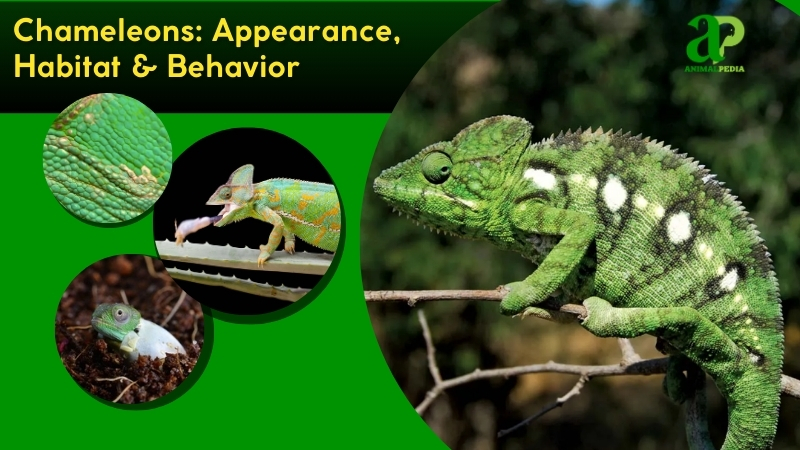Mediterranean house geckos captivate with their delicate, translucent bodies and nocturnal grace. About 10 species exist in the Hemidactylus genus, thriving across Mediterranean regions. This article explores their appearance, habitats, and behaviors.
The Mediterranean house gecko (Hemidactylus turcicus) has a slender frame, typically 4-5 inches long. Its grayish-brown skin with darker speckles blends into rocky surroundings. Native to Mediterranean shores including Crete and Sicily, its large, lidless eyes help night vision—a key trait.
These reptiles prefer warm, dry habitats—coastal cliffs, stone walls, and human dwellings. Their range covers southern Europe, North Africa, and Middle Eastern islands. Agile climbers, they scale vertical surfaces using specialized toe pads, adapting perfectly to diverse Mediterranean ecosystems.
Not apex predators, these geckos hunt stealthily. They stalk insects—moths, spiders, and beetles—with quick, precise strikes. Nocturnal hunters, they avoid human contact, though they often inhabit homes. Their opportunistic feeding adapts to local prey.
Mating peaks in spring, with females laying 1-2 eggs in hidden crevices. Incubation lasts 6-8 weeks, producing tiny, independent hatchlings. These juveniles mature within a year and live 3-5 years. Their swift lifecycle maintains populations throughout their range.
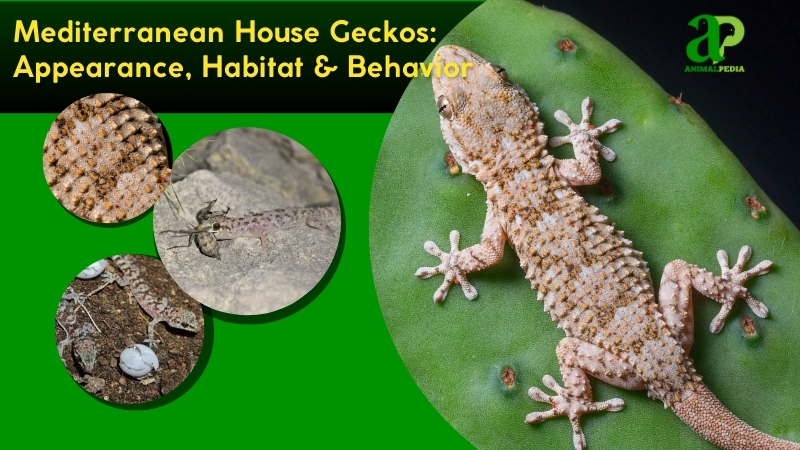
What do the Mediterranean House Geckos look like?
The Mediterranean house gecko features a sleek, elongated body measuring 3-5 inches from snout to tail. Its translucent skin is grayish-brown with darker speckles, providing perfect camouflage against Mediterranean walls and rocks. The body has fine, smooth scales.
The gecko’s triangular head contains large, lidless eyes that glow in low light, enhancing its nocturnal hunting abilities. A short, sticky tongue catches prey with quick strikes. Its flexible neck allows rapid directional changes when pursuing insects or evading predators.

Specialized toe pads distinguish this species (Hemidactylus turcicus). These adhesive structures contain microscopic setae that create molecular bonds with surfaces, enabling the gecko to climb vertical walls and even across ceilings. Its slender, banded tail can detach when threatened and later regenerate—a defense mechanism called autotomy.
Unlike the common house gecko (Hemidactylus frenatus), the Mediterranean species lacks bright markings and instead features subtle, muted tones. Its larger eyes outperform those of the Moorish gecko (Tarentola mauritanica), improving night vision. The Mediterranean gecko’s superior adhesive system surpasses that of other Hemidactylus species, enhancing its vertical climbing ability and making it an exceptional wall-dwelling reptile.
How big do Mediterranean House Geckos get?
Mediterranean house geckos typically measure 4 to 5 inches (10-13 centimeters) from snout to tail tip, with weights ranging from 0.7 to 1.4 ounces (20-40 grams). These dimensions highlight their compact, agile structure, which is perfectly suited for navigating rocky terrain and human dwellings. Adults generally range from 4.3 to 4.9 inches (11-12.5 centimeters) in length, with their slender, often regenerating tails contributing nearly half of this range, as noted in Mediterranean field studies.
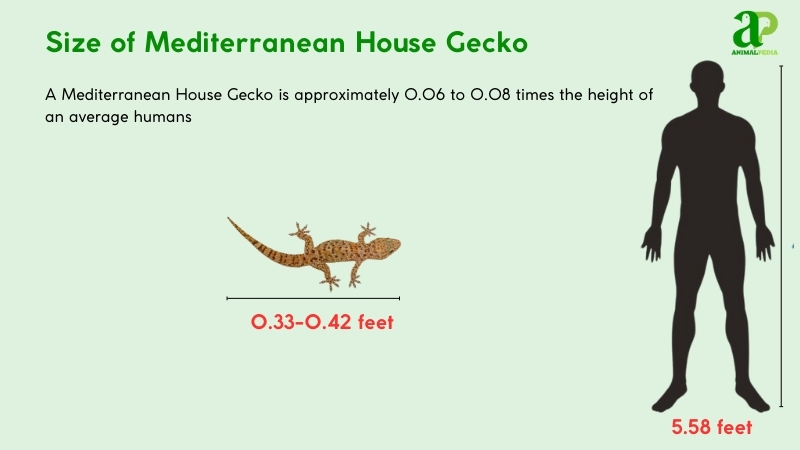
The largest recorded individual, found on Crete, Greece, measured 5.9 inches (15 centimeters) and weighed 1.8 ounces (50 grams), according to a 2018 study (Kotsakiozi et al., 2018).
Males typically stretch 0.1 to 0.3 inches (0.3-0.8 centimeters) longer and weigh 0.07 to 0.14 ounces (2-4 grams) more than females, reflecting subtle sexual dimorphism tied to territorial needs. The table below details these variations.
| Trait | Male | Female |
| Length | 4.7-5.0 in (12-12.7 cm) | 4.5-4.7 in (11.5-12 cm) |
| Weight | 1.4-1.6 oz (40-45 g) | 1.3-1.4 oz (37-40 g) |
What are the unique physical characteristics of the Mediterranean House Geckos?
The Mediterranean house gecko displays distinctive adaptations: adhesive toe pads and lidless, oversized eyes. Unlike most characteristic reptiles, its toes have microscopic setae—hair-like structures that enable vertical climbing with minimal effort. These features, combined with its translucent, speckled skin, set it apart from similar species such as Tarentola mauritanica. Its regenerative tail with bold banding patterns demonstrates its evolutionary resilience in challenging environments.

Research confirms these features as evolutionary advantages. Kotsakiozi’s 2018 study revealed that each toe pad contains thousands of setae arranged in a lamellar structure, which create van der Waals forces for secure grip on various surfaces. The gecko’s fixed bulbous eyes enhance night vision, specifically adapted for Mediterranean nocturnal conditions. Its thin but resilient skin facilitates efficient temperature regulation, an uncommon trait among reptiles with thicker scales. These specialized characteristics result from phylogenetic development, making this gecko an exceptionally adapted survivor in its habitat.
How do Mediterranean House Geckos adapt with their unique features?
Mediterranean house geckos (Hemidactylus turcicus) survive through adaptations. Their specialized toe pads contain thousands of microscopic setae that generate van der Waals forces, enabling them to climb vertical surfaces like stone walls, cliffs, and trees. This climbing ability helps them escape predators and hunt insects efficiently across Mediterranean habitats.
Their large, lidless eyes contain specialized photoreceptors that enhance night vision, which is essential for detecting prey in low-light conditions. The gecko’s sensitive dermis perceives subtle vibrations, providing early warning of approaching threats. Tympanic membranes in their small ear openings detect minute sounds of insect movement, improving hunting success rates. Their projectile tongue, covered with sticky mucus, captures prey rapidly, supporting their nocturnal feeding behavior.
These morphological adaptations, refined through natural selection, enable Hemidactylus turcicus to thrive in diverse microhabitats from coastal regions to inland rocky terrains throughout the Mediterranean basin. Their thermoregulatory capacity and water conservation mechanisms further support survival in seasonally dry environments.
Anatomy
The Mediterranean house gecko thrives across warm coastal regions thanks to highly adapted internal systems. Each physiological feature reflects millions of years of evolutionary refinement, allowing this small reptile to efficiently exploit nocturnal niches and arid environments.
- Respiratory System: Geckos breathe through lungs, supported by a simple diaphragm. Air flows via the nostrils, enabling efficient oxygen uptake for their active, nocturnal lifestyle in warm climates.
- Circulatory System: A three-chambered heart pumps blood, mixing oxygenated and deoxygenated flows. This supports their modest metabolic demands across Mediterranean habitats.
- Digestive System: A short, efficient gut processes insects—moths, spiders, beetles. The stomach and intestines break down prey quickly, suiting their opportunistic diet.
- Excretory System: Kidneys filter waste products into uric acid, which is expelled via a cloaca. This conserves water, vital for the arid coastal environments they inhabit.
- Nervous System: A compact brain and spinal cord drive keen senses. Large optic nerves enhance night vision, coordinating swift predator evasion and hunting.
Together, these anatomical systems enable Mediterranean house geckos to survive and flourish in demanding environments, balancing metabolic efficiency, predator awareness, and resource conservation with precision.
Where do Mediterranean House Geckos live?
Mediterranean house geckos (Hemidactylus turcicus) inhabit southern Europe, North Africa, and the Middle East. They thrive in coastal Mediterranean regions, including Crete, Sicily, and Tunisia. These adaptable reptiles concentrate in urban environments, rocky outcroppings, and stone walls throughout the Mediterranean basin, preferring warm, dry microhabitats.
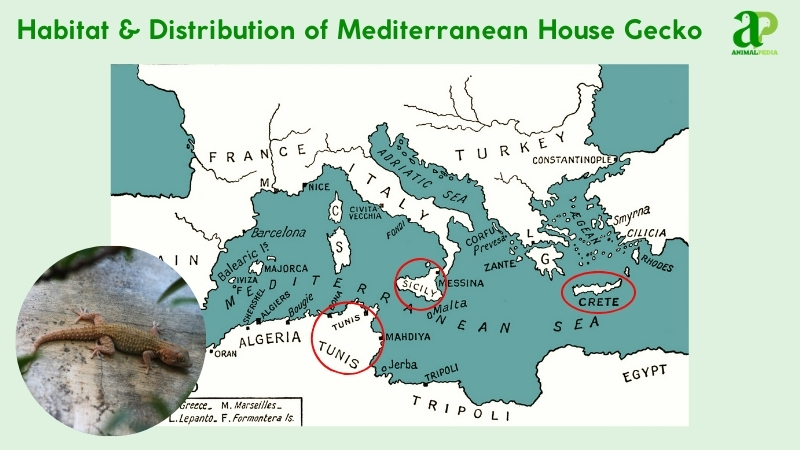
Their native habitat provides ideal conditions with hot summers (25-35°C, 77-95°F) and mild winters, perfectly suited to their ectothermic physiology. These geckos subsist on abundant arthropods—moths, flies, spiders—while using structural crevices for shelter and protection. Research by Carranza & Arnold (2016) confirms their presence in these regions for thousands of years, showing no significant migration patterns. Their distribution closely follows human architecture, suggesting ancient dispersal along trade routes, a theory supported by mitochondrial DNA analysis and phylogeographic studies.
How do seasonal changes affect their behavior?
Mediterranean house geckos display seasonal behavioral shifts to survive fluctuating climates. Their yearly cycle reflects adaptations to changing temperatures and resource availability across their environments.
- Warm Season (April-September): Geckos turn nocturnal, hunting insects—moths, beetles—under the cover of darkness. They mate and lay eggs, thriving in temperatures of 77-95°F (25-35°C).
- Cool Season (October-March): Activity drops as temperatures fall below 59°F (15°C). They seek shelter in crevices or homes, entering brumation—a light dormancy—to conserve energy until warmth returns.
By adjusting their activity and reproductive timing to seasonal cues, Mediterranean house geckos ensure survival and reproductive success in both urban and natural habitats.
What is the behavior of Mediterranean House Geckos?
Mediterranean house geckos are nocturnal reptiles, known for their adaptability and specialized behaviors that help them thrive in diverse environments. From their feeding habits to social structures, these geckos showcase survival tactics, honed for their specific ecological niche.
- Feeding Habits: They hunt insects—moths, spiders, beetles—using stealthy, precise strikes. Diet adjusts to local prey availability.
- Bite & Venomous: Non-venomous; they rarely bite humans. Their jaws target small prey, posing no threat.
- Daily Routines: Active at night, they rest in crevices by day. Movements peak in warm months.
- Locomotion: Agile climbers, they scale walls with adhesive toe pads. Speed aids predator evasion.
- Social Structures: Solitary, they avoid interaction beyond mating. Territories overlap without conflict.
- Communication: Vocal chirps signal territory or mates. Subtle and high-pitched, it’s effective.
These behaviors reveal how the Mediterranean house gecko is a finely tuned survivor in its environment. Whether hunting, evading predators, or communicating, each action enhances its chances of survival in often challenging conditions.
What do Mediterranean House Geckos eat?
Mediterranean house geckos are strict carnivores, preying on insects like moths, spiders, and beetles—their favorites. These geckos won’t attack humans; their small jaws target tiny prey. They stalk prey at night, using sticky tongues to snatch and swallow whole. If prey exceeds their gape (rarely), they abandon it to avoid choking.
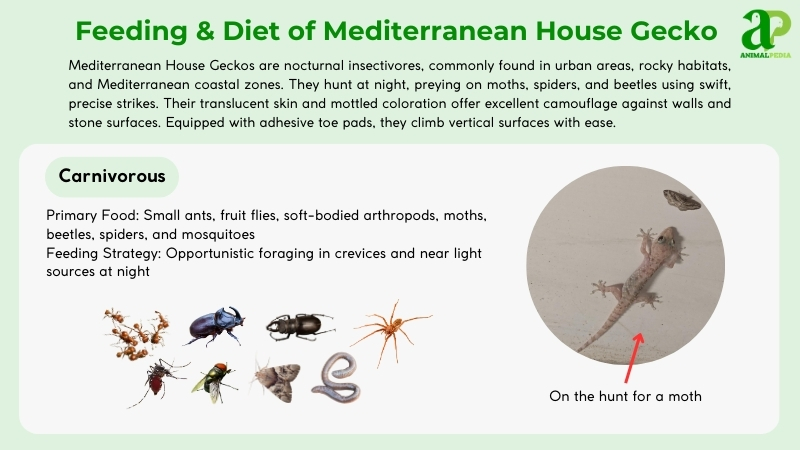
- Diet by Age
Mediterranean house geckos start by consuming small insects such as flies and spiders. As they mature, they target larger prey, including moths and beetles. Adults continue to hunt a variety of insects, adapting their diet to the availability of prey.
- Diet by Gender
Both male and female Mediterranean house geckos feed on similar insect prey, with no significant dietary differences. Larger males may cover more ground due to their larger territories, but their food preferences remain the same.
- Diet by Seasons
During warmer months, geckos forage actively at night, feeding on abundant insects. In cooler months, their activity slows and they consume less, surviving on stored energy as they enter a period of reduced feeding.
How do Mediterranean House Geckos hunt their prey?
Mediterranean House Geckos are skilled hunters, showcasing their agility and precision in capturing prey. These geckos rely on their sharp eyesight and lightning-fast reflexes to secure their next meal. In their hunting strategy, they use their camouflage to blend seamlessly into their surroundings, patiently waiting for unsuspecting insects to come into striking range.

When a potential meal is spotted, Mediterranean House Geckos spring into action with speed. They swiftly dart towards their prey, using their powerful jaws and sharp teeth to grip and secure it.
Their agile bodies and nimble footwork give them an advantage in pursuing their prey, as they can climb walls, ceilings, and smooth surfaces effortlessly, allowing them to chase insects wherever they may hide.
With their impressive hunting skills, Mediterranean House Geckos are adept predators in their natural habitat, demonstrating their ability to adapt and thrive by using speed, agility, and keen senses to capture prey effectively.
Are Mediterranean House Geckos venomous?
Mediterranean House Geckos (Hemidactylus turcicus) are not venomous. They capture prey through speed and agility rather than toxic secretions.
These reptiles employ specialized hunting tactics to catch insects and small invertebrates. With exceptional vision and a refined olfactory system, they detect prey before striking with lightning-fast reflexes. Their specialized saliva contains digestive enzymes that break down the exoskeletons of their prey—a natural adaptation that eliminates any need for venom.
As nocturnal predators, these geckos provide essential pest control services in their habitats. Their non-venomous nature makes them harmless to humans, yet they are efficient hunters in the Mediterranean ecosystem. Their success demonstrates evolutionary adaptation through specialized hunting methods rather than toxin production.
When are Mediterranean House Geckos most active during the day?
During the early hours of the day and as the sun sets, Mediterranean House Geckos are most active, scuttling around in search of food and potential mates. These unique creatures enjoy soaking up the morning sunlight to prepare for their day of exploring their environment.

As the temperature rises throughout the day, they seek out cool, shady spots to rest and conserve energy. When the sun is at its peak, they often hide under rocks or in crevices to avoid the intense heat.
As night approaches, the geckos come out once more, eager to hunt for insects under the soft glow of twilight. This time of day is ideal for them to showcase their hunting skills, as their prey becomes more active too. You may even hear them chirping as they communicate in their distinctive ways.
How do Mediterranean House Geckos move on land and water?
Mediterranean House Geckos show locomotion capabilities in both terrestrial and aquatic environments. These reptiles possess specialized adhesive toe pads with microscopic setae that generate van der Waals forces, enabling them to adhere to vertical surfaces and even traverse ceilings upside down. On land, they exhibit rapid burst movements, using their muscular limbs to accelerate quickly when pursuing prey or evading predators.

In water, contrary to what many assume, Mediterranean House Geckos demonstrate competent swimming abilities. They employ lateral undulation—a side-to-side movement of their body and tail—to propel themselves through water efficiently. This dual-environment mobility highlights their evolutionary adaptations for survival in their native Mediterranean habitats.
The biomechanics of these geckos represent a fascinating example of evolutionary adaptation. Their adhesive locomotion on vertical surfaces involves complex interactions between their specialized toe structures and various substrates, while their aquatic propulsion relies on body flexibility and coordinated muscle contractions. These movement capabilities allow Mediterranean House Geckos to exploit diverse microhabitats within their range.
Prefer gliding to sprinting? See the Flying gecko, a bark mimic that coasts between trees and lives high in the canopy.
Do Mediterranean House Geckos live alone or in groups?
Mediterranean House Geckos are solitary reptiles, preferring to live alone rather than in groups. They thrive in isolation, hunting and exploring independently without social interaction. These small nocturnal lizards establish and defend individual territories against other geckos, maintaining exclusive control over their hunting grounds and shelter sites.
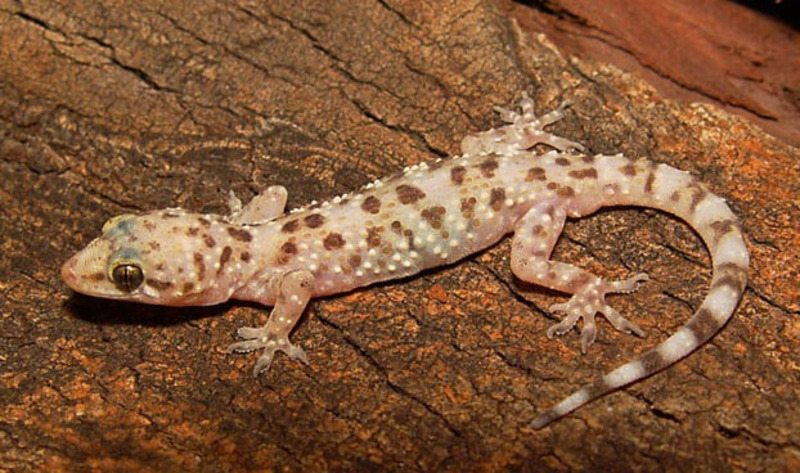
While they may temporarily tolerate other geckos during breeding season or in chance encounters, Mediterranean House Geckos fundamentally prefer solitude. Adult specimens typically avoid prolonged contact with conspecifics outside of reproductive necessities, reflecting their natural behavioral ecology.
You’ll typically observe these common household geckos (Hemidactylus turcicus) resting alone during daylight hours or hunting insects independently after dark, each maintaining its own spatial domain within the habitat.
How do Mediterranean House Geckos communicate with each other?
Mediterranean House Geckos use various methods to communicate with one another. They chirp distinctively, especially during the mating season, to attract potential mates or establish territory boundaries.
Besides vocalizing, these geckos utilize body language for communication. They engage in head bobbing, tail wagging, and posturing to convey messages to nearby geckos. These visual cues help them establish dominance, signal potential threats, or indicate submission.
Moreover, scent marking is another key form of communication among Mediterranean House Geckos. They release pheromones through specialized glands to mark territory or attract mates.
How do Mediterranean House Geckos reproduce?
Mediterranean house geckos (Hemidactylus turcicus) reproduce sexually through oviparous reproduction. Breeding begins in spring (April–May) when temperatures rise and insect prey becomes abundant. Males attract females with distinct high-pitched chirps, tail vibrations, and physical displays—behaviors that enhance mating success. These courtship rituals typically occur on warm nights near artificial light sources where food concentrates.
After successful mating, females deposit 1–2 calcified eggs per clutch, laying multiple clutches several weeks apart throughout the breeding season. Each egg weighs approximately 0.1 ounces (3 grams). Females select protected oviposition sites, including wall crevices, stone undersides, and sheltered cavities. These locations offer concealment but no parental care; eggs are unattended after laying. Environmental factors such as drought or predation pressure can significantly affect reproductive success.

Embryonic development takes 6–8 weeks, with hatchlings emerging at roughly 1.5 inches (4 centimeters) in total length. Juvenile geckos are fully independent at birth and immediately begin hunting small arthropods. Growth proceeds rapidly under optimal conditions, with sexual maturity achieved in 9–12 months. Wild populations typically live 3–5 years, though longevity increases in stable habitats.
Females produce up to 6 clutches annually in warmer climates, contributing to the species’ colonization success and resilience in disturbed environments. This reproductive strategy enables Mediterranean house geckos to establish viable populations quickly when introduced to suitable habitats.
How long do Mediterranean House Geckos live?
Mediterranean House Geckos typically live 3 to 5 years in the wild. Under ideal captive conditions, these reptiles may survive up to 8 years (Perry et al., 2019). Males and females show equal longevity with no notable differences between sexes. Their complete life cycle spans 9 to 12 months from hatchling to mature adult.
Survival rates drop significantly due to predation and environmental challenges. These mortality factors drive population turnover throughout both their native Mediterranean habitat and regions where they’ve been introduced as non-native species.
What are the threats or predators that Mediterranean House Geckos face today?
Mediterranean house geckos confront habitat loss, climate shifts, and predation. Human activity and nature test their resilience.
- Habitat Loss: Urban sprawl destroys rocky shelters, slashing populations by 20-30% in dense areas (Carranza & Arnold, 2016).
- Climate Change: Rising temperatures disrupt breeding, cutting egg viability by 15% in hotter zones.
- Predation: Natural enemies thin numbers, especially juveniles, with survival rates dropping 25% in predator-rich sites.
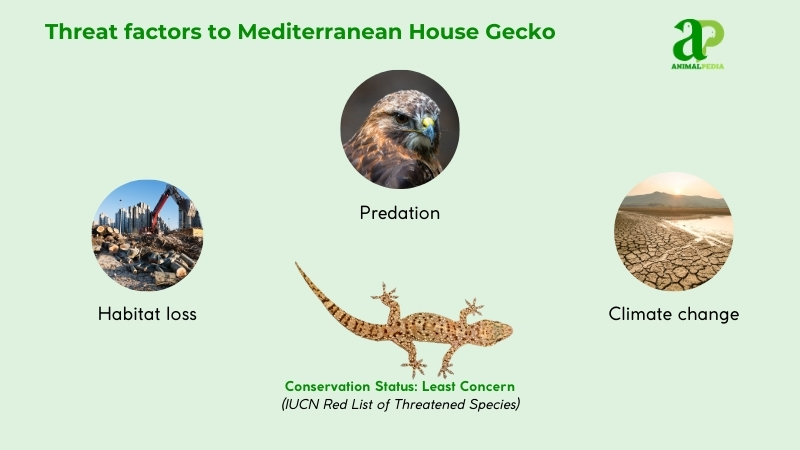
Predators include birds (owls, kestrels), snakes (Malpolon monspessulanus), and cats. Nocturnal hunters like owls snag geckos off walls, while snakes raid crevices. Feral cats, abundant in Mediterranean towns, kill dozens each year in each region.
Human impact looms large. Pesticides shrink insect prey, stunting gecko growth, while buildings replace habitats. Research (Carranza & Arnold, 2016) links a 10% decline in the range to urbanization since 2010. Conservation lags, but awareness could curb losses.
Are Mediterranean House Geckos endangered?
Mediterranean house geckos are not endangered. They thrive across their range, showing strength despite environmental challenges.
The International Union for Conservation of Nature (IUCN) classifies Hemidactylus turcicus as “Least Concern.” This status reflects its widespread distribution and stable populations throughout southern Europe, North Africa, and the Middle East. Unlike threatened reptile species, these geckos adapt well to human settlements, offsetting potential habitat destruction. Their opportunistic hunting behavior and robust reproductive rates bolster their numbers, keeping them far from extinction.
Population counts are limited, but scientists estimate millions exist worldwide. Research by Carranza and Arnold (2016) documents densities of 50-100 specimens per hectare in prime Mediterranean ecosystems such as Crete and Sicily. Urban development actually helps their expansion, with no meaningful population decline observed since 2010. Their conservation status is secure and stable.
What conservation efforts are underway?
Mediterranean house geckos require no active conservation measures. The International Union for Conservation of Nature (IUCN) classifies them as “Least Concern,” with thriving populations that continue to expand into new territories as an invasive species. Major conservation organizations like the World Wildlife Fund (WWF) have initiated no time-sensitive projects for these resilient reptiles.
Legal protections are minimal. In their native Mediterranean habitat, no specific legislation addresses their preservation due to their abundance. Conversely, in invaded regions such as Australia, biosecurity regulations, such as the Biosecurity Act 2015, strictly prohibit unauthorized introductions to limit ecological impact. These laws ban importation and release to shield native reptile species from competition and habitat disruption.
Captive breeding programs for conservation purposes don’t exist. These geckos reproduce efficiently without human intervention—females produce 2-6 eggs annually with approximately 80% hatching success under favorable conditions. Zoological institutions occasionally breed them for educational exhibits rather than species preservation. The European Association of Zoos and Aquaria (EAZA) documents limited breeding initiatives, including a 2019 Spanish program that produced 15 juvenile geckos primarily for display purposes.
Monitoring organizations like GeckoWatch focus on tracking their geographic spread rather than protecting them. Their success story lies in their natural adaptability—establishing self-sustaining colonies in over 24 U.S. states demonstrates their exceptional survival capacity without conservation support.
Frequently Asked Questions
Can Mediterranean House Geckos Change Color Like Some Other Species?
Yes, Mediterranean house geckos are like chameleons and can change color to blend in. Their camouflaging ability helps them evade predators. It’s a fascinating adaptation that showcases their survival skills in the wild.
What Is the Average Lifespan of Mediterranean House Geckos in Captivity?
In captivity, the average lifespan of Mediterranean house geckos ranges from 5 to 10 years. Remember to provide proper care, a suitable environment, and a balanced diet to help these amazing creatures thrive and live longer.
Do Mediterranean House Geckos Vocalize or Make Any Sounds?
Yes, Mediterranean house geckos vocalize. They use chirps and clicks for communication. These sounds can vary depending on the situation. It’s fascinating to listen to your gecko express itself through these interesting vocalizations.
Are Mediterranean House Geckos Known to Cause Any Allergies in Humans?
Yes, Mediterranean house geckos can cause allergies in humans. Their droppings and shed skin can trigger reactions in sensitive individuals. It’s important to maintain a clean environment to reduce the risk of allergens.
Can Mediterranean House Geckos Regrow Their Tails if They Lose Them?
Yes, Mediterranean house geckos can regrow their tails if they lose them. Their unique ability is a fascinating survival mechanism often observed in various lizard species. You may witness this phenomenon firsthand if you encounter these geckos.
Conclusion
To wrap up, Mediterranean House Geckos are creatures with their unique physical traits, adaptive behaviors, and impressive climbing abilities. These nocturnal reptiles excel as hunters in their ecological niches, using distinctive chirping vocalizations for communication and facing threats from natural predators, including snakes and raptors. Their specialized chromatophores allow for color adaptation, enhancing their survival through effective camouflage.
The Hemidactylus turcicus represents a fascinating species in the lizard family Gekkonidae, demonstrating evolutionary success through specialized toe pads and its capacity to thrive in anthropogenic habitats. These geckos continue to expand their range as commensal organisms alongside human development, making them an intriguing subject for herpetologists and casual observers alike.





